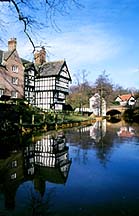A Brief History
Permission was granted in 1759 to start construction on what would be the forerunner of
all modern canals; The Bridgewater Canal in Lancashire. It was named after its owner the
3rd Duke of Bridgewater, Francis Egerton, who financed the canal at great cost to himself.
According to the Manchester
Mercury in 1761, ‘The canal will be of very great use commercially, as well as
ornament.’ The engineers involved with the huge and revolutionary project were
John Gilbert and later James Brindley.
The ‘Canal Duke’, as he affectionately became known, owned mines
in the Worsley area during the 1750’s but the cost of transporting coal to Manchester
and the regular flooding of the mines kept the price too high. In order to
resolve the matter the Duke embarked on one of the most remarkable feats
of engineering. This involved the cutting of two canals into the sandstone
rock face at a place adjacent to the canal known locally as the
‘Delph’.
These canals eventually met up with the coal seams and
special boats, known as ‘mine boats’, or ‘M boats’ enabled
the quick transportation of coal into Manchester. It also helped to keep
the mines drained. This project reduced the cost of coal by 50 percent, which
greatly benefited the people of Manchester.
Unfortunately the underwater canals were eventually closed in 1889
and the general public were barred from entering for safety reasons.
The unusual orange-coloured canal water at Worsley is caused by iron compounds
from the sandstone seeping into the water as it travels through the maze
of some 50 miles of underground canals on four different levels, thus producing
the ‘rusty’ appearance.

Orange coloured water |
The Bridgewater heralded the beginning of the successful canal age in England
and helped promote the Industrial Revolution. A monument dedicated to the
Duke stands on Worsley Village Green, close to the canal. In 1762 the Duke was given
permission to extend the canal east to Runcorn which meant the route to Liverpool was
completed by 1776, and by 1795 it had been linked to Leigh in a westward direction.
The canal was eventually sold in 1872 to the Bridgewater Navigation Company for over a
million pounds, who later sold it onto the Manchester Ship Canal Company in 1885.
As you walk along the canal the Packet House and Boatsteps, which were built
in the late 1700’s, dominate the scene. This was where passengers got
on and off the ‘packet boats’ that travelled the canal daily. The
Duke had been quick to recognise the potential for such a fare-paying passenger
service and started using his own boats in 1769.

Monument |
|

Packhouse |
|

The Boat House |
The Worsley boatyards, still in use today, also date from the 1760’s.
Most of the barges that used the canal and worked the mines in the Duke’s
time were built and repaired there. Infact they house the oldest inland waterway
dry dock in Britain.
The Boat House, with its humbug striped doors, was built to house the Royal
Boat that was used to transport Queen Victoria along the canal when she visited
Worsley in 1851. It was commissioned by the 1st Earl of Ellesmere, a descendant
of Francis Egerton. However, Queen Victoria is not the only royal to have
visited Worsley, in 1967 Queen Elizabeth stood on the humpbacked bridge that
spans the canal when she opened the park adjacent to the waterway.
Nowadays, the canal has little value as a carrier of commercial
goods, but
with its good waterway connections its worth as a place for leisure boating
is
growing steadily. Worsley has several local interest trails, including
woodland walks and
historical sites and information can be easily obtained
form the local library or from the
notice boards that are situated along
the canal walks.
COPYRIGHT NOTICE:
This illustrated article, (including photographs) is Copyrighted ©
2001 by Janet Wood. All Rights Reserved. And must not to be reproduced without
permission from the author. If you copy the text and/or
images from this page and use them on your own web site, publish, or include
this article in any collection without the authorís permission, you are in
violation of international copyright law.
PLEASE NOTE: This copyright notice does not affect any website owner who would like to add an external link to this webpage from their own website. Also, if you feel that your website content would compliment this article please email us and we will be only too happy to consider placing a reciprocal link back to you.

